How Orbital Hybridization Affects Bond Strengths
Understanding the concept of hybrid orbitals (see previous post) lets you make accurate predictions about trends in bond strengths. In this post we’ll give several examples of how to do this.
1. A Quick Quiz
Let’s start with a quick quiz.
What’s the strongest C–H bond, below?
(In other words, which C–H bond has the highest bond-dissociation energy?)

The answer is C.
- In a), the carbon is sp3 hybridized and the bond dissociation energy is 105 kcal/mol
- In b), the carbon is sp2 hybridized and the bond dissociation energy is 110 kcal/mol
- In c), the carbon is sp hybridized and the bond dissociation energy is 126 kcal/mol
2. Key Principle On Orbital Hybridization And Bond Strengths: The Greater The s-character, The Stronger The Bond
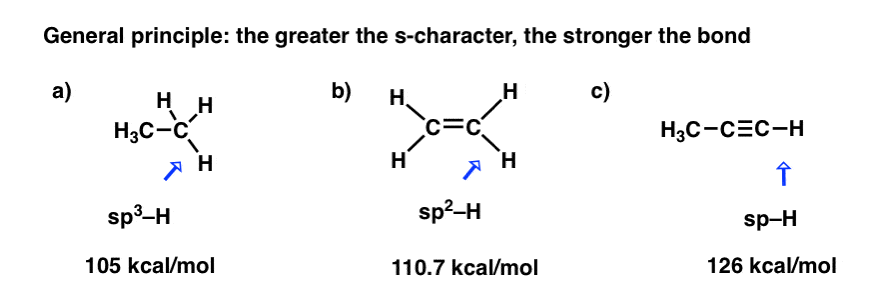
Note that the trend for bond strengths, above, is sp > sp2 > sp3
In other words, the more s-character on carbon, the stronger the bond.
Let’s try this again. What about these three C–C bonds?
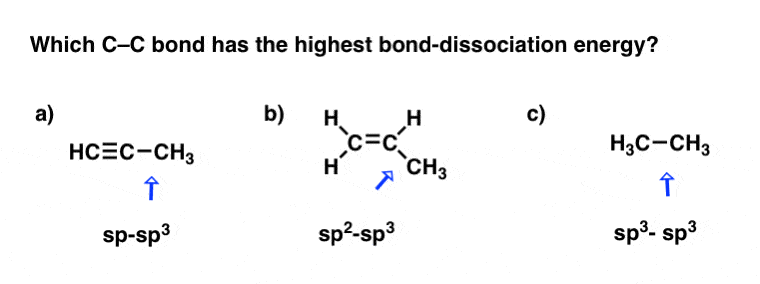
Hopefully you ranked them A > B > C .
All else being equal: an sp-sp3 bond is stronger than an sp2-sp3 bond, which in turn is stronger than an sp3-sp3 bond.
Why?
3. Electrons In s-Orbitals Are Closer To the Nucleus Than Electrons In The Corresponding p-Orbitals
On average: electrons in s orbitals are closer to the nucleus (and therefore feel a greater effective positive charge) than electrons in the corresponding p orbitals.
Electrons in an sp orbital (50% s-character) will therefore experience a greater attractive force to the nucleus than electrons in an sp2 (33% s-character) or sp3 (25% s-character) orbital.
“Bond dissociation energy” (BDE) mentioned above, is a measure of the energy required for homolytic cleavage of a bond (homo = same; lysis = breaking). [See post: Bond Dissociation Energies = Homolytic Cleavage]
That is, it measures the energy required for breakage of the bond such that each atom ends up with the same number of electrons, such as the reactions below:
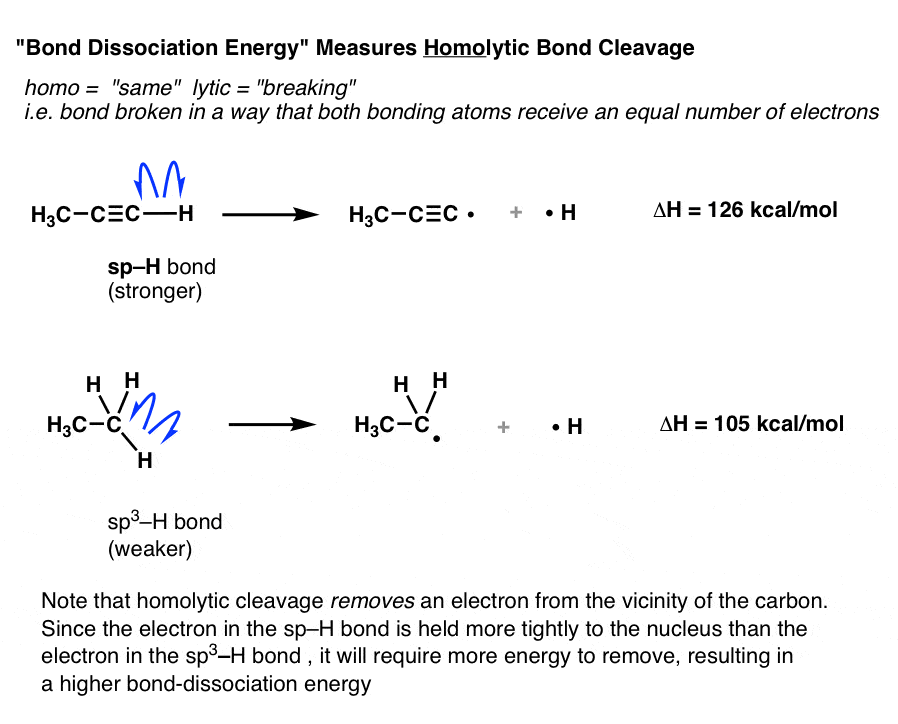
In the homolytic cleavage reactions above, a single electron is removed from the C–H molecular orbital and placed on hydrogen, which dissociates. The other electron remains on carbon.
The bond dissociation energy for the sp–H bond is higher than that for sp3–H because more force (energy) is required to remove an electron from the more tightly-held sp–H molecular orbital and place it exclusively on the hydrogen atom.
So electrons in an orbital with more s character will be closer to the nucleus and feel a stronger electrostatic force.
This helps to explain the higher bond energy.
Recognizing the type of bonds in molecules is a key skill. (see also: C-C sigma bonds come in six varieties, C-C pi bonds come in one).
For most purposes, this ends the key lesson of the post.
4. Summary: All Else Being Equal, The Greater The s-Character, The Stronger The Bond
But… if you find yourself trying to reconcile an apparent contradiction that comes from another part of the course, read on.
5. Bonus Section: An Answer To A Question A Few People Might Be Asking
Alkynes (pKa 25) are stronger acids than typical alkanes (pKa > 50).
For example, alkynes are readily deprotonated by strong bases such as NaNH2, whereas alkanes are not:
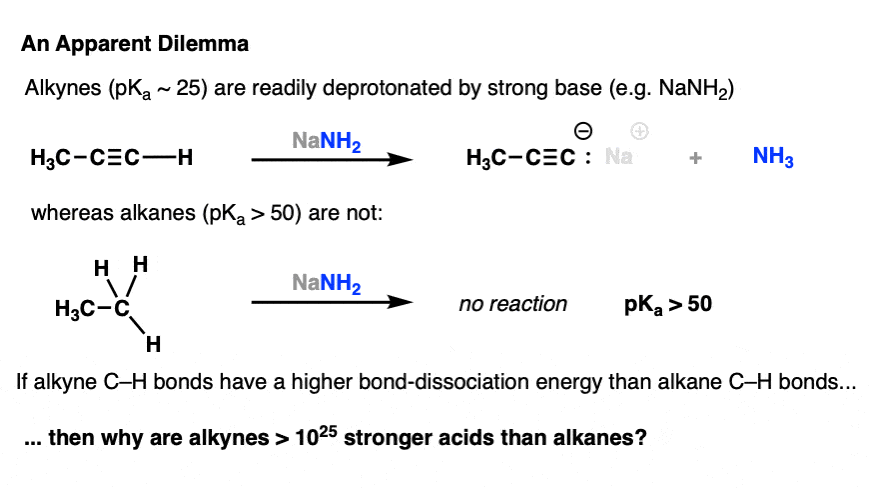
Why? Because the C–H bond in an alkyne has more s-character, and the resulting lone pair on carbon is held more tightly to the nucleus, rendering the conjugate base more stable.
Oh dear. There seems to be an angry mob approaching.
WAIT! You just said that alkyne C–H bonds are stronger than alkane C–H bonds because they have more s-character and now you are saying that they are easier to break because they have more s-character.
Shouldn’t that make alkynes less acidic because the C–H bonds have more s-character? There is a perfectly logical explanation for this!
6. Homolytic versus Heterolytic Bond Cleavage
What’s the source of the confusion here?
Let’s follow the electrons.
Ultimately the resolution to this dilemma is recognizing the difference between homolytic cleavage (which is what bond dissociation energy measures) and heterolytic cleavage (which is what occurs in an acid-base reaction, the loss of H+ ).
Let’s look at these two processes.
In homolytic cleavage of a C–H bond, an electron is completely removed from the vicinity of the carbon and placed on hydrogen. Because of the greater s-character of the bond, it is more difficult to remove an electron from an sp-hybridized carbon than from an sp3 hybridized carbon. As we said above, that’s why the bond-dissociation energies for alkyne C–H bonds are higher than for alkane C–H bonds.
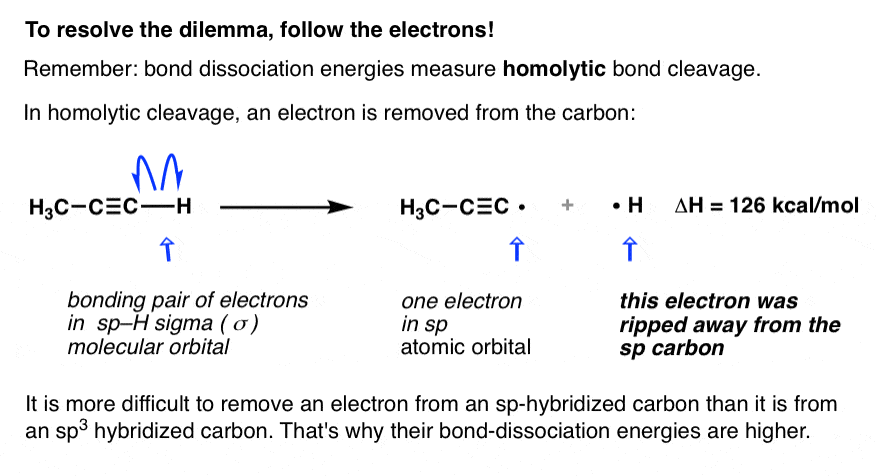 In an acid-base reaction, the C–H bond also breaks, but it breaks in such a way that the pair of electrons stays on the carbon atom. Since the bond breaks in a way that leads to an uneven distribution of electrons, it is called heterolytic bond cleavage (hetero = different, lysis = breaking).
In an acid-base reaction, the C–H bond also breaks, but it breaks in such a way that the pair of electrons stays on the carbon atom. Since the bond breaks in a way that leads to an uneven distribution of electrons, it is called heterolytic bond cleavage (hetero = different, lysis = breaking).
Let’s say that again: in an acid base reaction, the pair of electrons stays on carbon, resulting in a negatively-charged carbon atom (a “carbanion”).
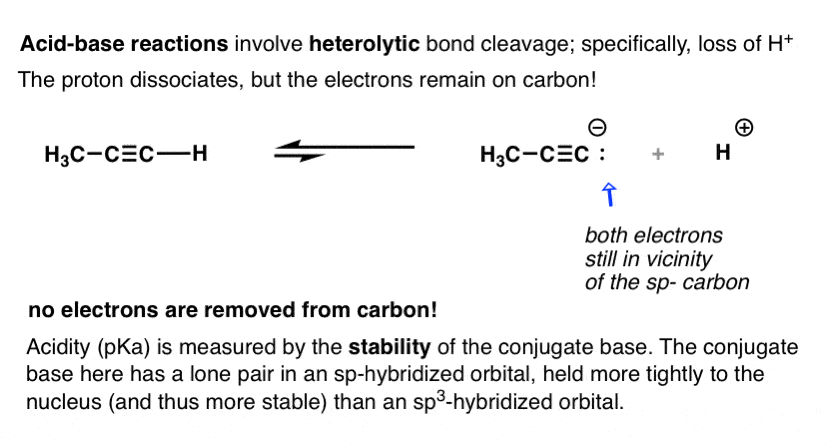
Acidity, as measured by pKa, is a measure of the equilibrium between an acid and its conjugate base. The more that the equilibrium favours the conjugate base, the lower the pKa and the stronger the acid. In other words:
Any factor which makes the conjugate base more stable, increases acidity.
- In the conjugate base of an alkyne, the lone pair is held in an sp- orbital with 50% s-character.
- In the conjugate base of an alkane, the lone pair is held in an sp3 orbital with 25% s-character.
What lone pair will be more stable?
The lone pair held more tightly to the nucleus – that is, the sp-orbital.
That’s why alkynes are more acidic than alkanes: the conjugate base is more stable.
Hopefully this makes it clearer that stronger C–H bonds and greater C–H acidity are two sides of the same phenomenon.
[You might find it helpful to think of sp orbitals as having a greater effective electronegativity than sp2 orbitals, which in turn have a greater electronegativity than sp3 orbitals. So the reason for the greater acidity of alkynes relative to alkenes is not really so different than the greater acidity of H–F relative to H2O. ]
7. A Test For You
At the risk of droning on, there is a third side of this phenomenon to consider.
Homolytic cleavage can only happen one way. But there are two ways to draw heterolytic cleavage of a C–H bond, and you might have noticed that I only showed one.
There’s a second (albeit unlikely) way heterolytic cleavage can happen. The pair of electrons in the C–H bond could migrate instead to hydrogen, not carbon, resulting in a hydride anion and a carbocation. [Again, very unlikely, but bear with me here].
Here’s a test I have for you. Based on everything we’ve gone through so far, which of the two products below (A or B) would be more stable?

Think it through.
- To form A, we have to remove a pair of electrons from an sp-hybridized carbon.
- To form B, we have to remove a pair of electrons from an sp3-hybridized carbon.
What’s more favourable?
- Reaction to give A would require removing two electrons from an sp-hybridized carbon.
- Reaction to give B would require removing two electrons from an sp3 hybridized carbon.
The reaction to give B should be much easier, because the electrons are less tightly held. And indeed, sp3-hybridized carbocations have been observed and even isolated.
In contrast, sp-hybridized carbocations such as A are extremely unstable and have never been observed directly. [Note 1]
This observation is also consistent with all the observations above!
8. One Last Thing: This Concept Also Explains Why CH3+ Is More Stable Than NH3+
As I said above, it can be helpful to think of sp-hybridized carbons as having a greater effective electronegativity than sp2-hybridized carbons, which in turn have greater electronegativity than sp3 hybridized carbons. We used this to rationalize why alkynes are stronger acids than alkanes, similarly to why H-F is a stronger acid than H2O.
This can also be flipped around, just as in our carbocation example above.
The greater the electronegativity of the atom, the more unstable electron-deficient species become.
This helps to explain why, for example, H3C+ (with six valence electrons) is much more stable than H3N+ (also with six valence electrons) which in turn is far more stable than oxygen or fluorine with six valence electrons; increasing electronegativity has the same effect on the stability of electron-deficient species as increasing s-character.
Next: Sigma bonds come in six varieties: Pi bonds come in one
